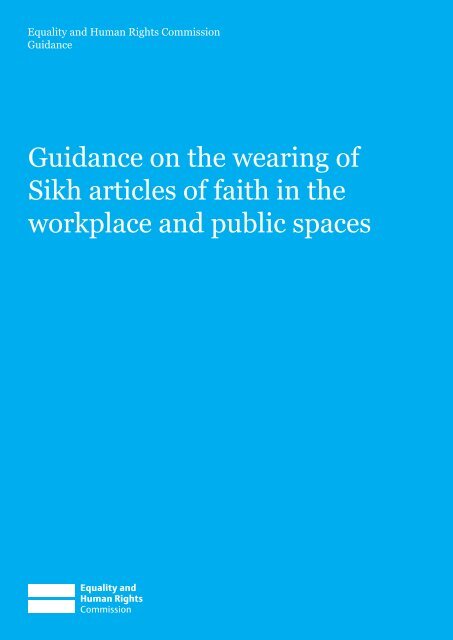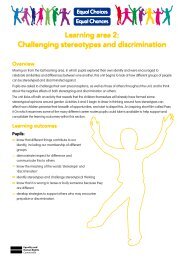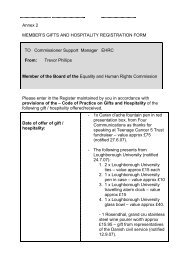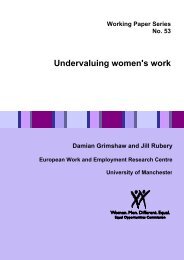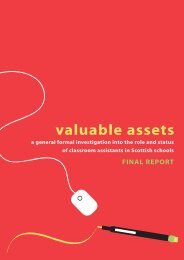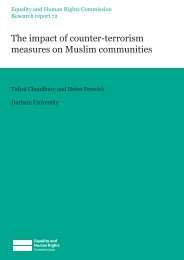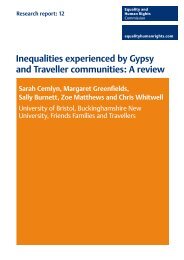Sikh articles of faith.indd - Equality and Human Rights Commission
Sikh articles of faith.indd - Equality and Human Rights Commission
Sikh articles of faith.indd - Equality and Human Rights Commission
Create successful ePaper yourself
Turn your PDF publications into a flip-book with our unique Google optimized e-Paper software.
<strong>Equality</strong> <strong>and</strong> <strong>Human</strong> <strong>Rights</strong> <strong>Commission</strong><br />
Guidance<br />
Guidance on the wearing <strong>of</strong><br />
<strong>Sikh</strong> <strong>articles</strong> <strong>of</strong> <strong>faith</strong> in the<br />
workplace <strong>and</strong> public spaces
Contents<br />
Introduction .............................................................................................. 1<br />
What is this guidance about <strong>and</strong> who should read it? .......................... 1<br />
How is this guidance organised <strong>and</strong> what should you read? ................ 2<br />
Definition <strong>of</strong> terms ................................................................................. 3<br />
Chapter 1: What the law says ............................................................. 5<br />
The <strong>Human</strong> <strong>Rights</strong> Act (HRA) .............................................................. 5<br />
The <strong>Equality</strong> Act 2010 .......................................................................... 6<br />
What is the Public Sector <strong>Equality</strong> Duty? ............................................. 8<br />
How is criminal justice legislation relevant? ......................................... 8<br />
Other provisions in the law for <strong>Sikh</strong> <strong>articles</strong> <strong>of</strong> <strong>faith</strong> .............................. 9<br />
Chapter 2: Employment ..................................................................... 10<br />
Key issues <strong>and</strong> good practice examples ............................................ 10<br />
Dress code ......................................................................................... 11<br />
Health <strong>and</strong> safety ................................................................................ 12<br />
Security .............................................................................................. 14<br />
Chapter 3: Education......................................................................... 15<br />
Turban ................................................................................................ 15<br />
Kara .................................................................................................... 15<br />
Kirpan ................................................................................................. 16<br />
Chapter 4: Goods, facilities <strong>and</strong> services .......................................... 17<br />
Accessing public buildings .................................................................. 18<br />
The Health Service ............................................................................. 19<br />
Airports ............................................................................................... 20<br />
Chapter 5: Further support ................................................................ 22
Introduction<br />
Sometimes the wearing <strong>of</strong> <strong>Sikh</strong> <strong>articles</strong> <strong>of</strong> <strong>faith</strong> may appear to conflict<br />
with the needs <strong>of</strong> an organisation <strong>and</strong> the lack <strong>of</strong> underst<strong>and</strong>ing <strong>of</strong> <strong>Sikh</strong><br />
<strong>articles</strong> <strong>of</strong> <strong>faith</strong> can inadvertently lead to tensions between the rights <strong>of</strong><br />
individuals <strong>and</strong> the rights <strong>of</strong> the organisation.<br />
Developments in legislation to make provision for the wearing <strong>of</strong> <strong>Sikh</strong><br />
<strong>articles</strong> <strong>of</strong> <strong>faith</strong> have shown that there are resolutions to longst<strong>and</strong>ing<br />
concerns for employers, service providers <strong>and</strong> individuals. To a certain<br />
extent, these developments have clarified the rights <strong>of</strong> those wearing<br />
<strong>Sikh</strong> <strong>articles</strong> <strong>of</strong> <strong>faith</strong>, but there still remains varying levels <strong>of</strong><br />
underst<strong>and</strong>ing <strong>and</strong> practice around this.<br />
This guidance aims to raise awareness <strong>of</strong> <strong>Sikh</strong> <strong>articles</strong> <strong>of</strong> <strong>faith</strong> <strong>and</strong> the<br />
concerns which may arise from the wearing <strong>of</strong> these. We hope that it<br />
will provide useful information for balancing the needs <strong>of</strong> individuals<br />
<strong>and</strong> service users with those <strong>of</strong> employers <strong>and</strong> public services.<br />
What is this guidance about <strong>and</strong> who should read it?<br />
The guidance explains current legislation as it applies to the wearing<br />
<strong>of</strong> <strong>Sikh</strong> <strong>articles</strong> <strong>of</strong> <strong>faith</strong>, 1 as well as the rights, duties <strong>and</strong> obligations<br />
associated with these. It highlights:<br />
• key issues facing employers, service providers <strong>and</strong> individuals <strong>of</strong><br />
<strong>Sikh</strong> <strong>faith</strong> with regards to the wearing <strong>of</strong> <strong>Sikh</strong> <strong>articles</strong> <strong>of</strong> <strong>faith</strong>, <strong>and</strong><br />
• good practice in relation to <strong>Sikh</strong> <strong>articles</strong> <strong>of</strong> <strong>faith</strong>.<br />
By providing this clarity on the law, as well as pragmatic good practice<br />
examples, the <strong>Equality</strong> <strong>and</strong> <strong>Human</strong> <strong>Rights</strong> <strong>Commission</strong> hopes that,<br />
where there is uncertainty or disagreement, this guidance can be used<br />
1 Please note that the legislation on religion <strong>and</strong> belief will apply to other religions,<br />
but for the purpose <strong>of</strong> this guidance we will be focusing on the wearing <strong>of</strong> <strong>Sikh</strong><br />
<strong>articles</strong> <strong>of</strong> <strong>faith</strong>.<br />
1
y individuals as well as organisations to solve any misunderst<strong>and</strong>ings<br />
relating to the wearing <strong>of</strong> <strong>Sikh</strong> <strong>articles</strong> <strong>of</strong> <strong>faith</strong>.<br />
This guide is not an authoritative statement <strong>of</strong> the law <strong>and</strong> is not<br />
intended as a substitute for taking appropriate legal advice on<br />
individual circumstances.<br />
You should read this guidance if you require:<br />
• clarification on how the law currently applies to the wearing <strong>of</strong><br />
<strong>Sikh</strong> <strong>articles</strong> <strong>of</strong> <strong>faith</strong><br />
• examples <strong>of</strong> best practice in dealing sensitively <strong>and</strong> fairly with<br />
observers <strong>of</strong> the <strong>Sikh</strong> <strong>faith</strong><br />
• a tool to strengthen good relations by promoting greater<br />
underst<strong>and</strong>ing between <strong>Sikh</strong>s <strong>and</strong> others<br />
• a guide for private <strong>and</strong> public sector organisations in terms <strong>of</strong> dignity<br />
<strong>and</strong> fairness at work, <strong>and</strong> service delivery with regards to the <strong>Sikh</strong><br />
community, <strong>and</strong> in promoting good relations, <strong>and</strong><br />
• links to other guidance on this topic.<br />
How is this guidance organised <strong>and</strong> what should you read?<br />
To help users <strong>of</strong> the guide find the information they require quickly we<br />
have structured the information as follows:<br />
• Chapter 1 sets out what the law says on race <strong>and</strong> religion or belief.<br />
• Chapter 2 provides information regarding the wearing <strong>of</strong> <strong>Sikh</strong> <strong>articles</strong><br />
<strong>of</strong> <strong>faith</strong> (the Five Ks <strong>and</strong> the turban, explained later in this section) in<br />
employment situations.<br />
• Chapter 3 provides information regarding the wearing <strong>of</strong> <strong>Sikh</strong> <strong>articles</strong><br />
<strong>of</strong> <strong>faith</strong> (the Five Ks <strong>and</strong> the turban) in education settings.<br />
• Chapter 4 provides information relating to goods, facilities <strong>and</strong><br />
services, <strong>and</strong> focuses on access to public buildings, the health<br />
service <strong>and</strong> airports.<br />
• Chapter 5 <strong>of</strong>fers sources for further support <strong>and</strong> information.<br />
2
This guide focuses on the wearing <strong>of</strong> the kara, kirpan <strong>and</strong> turban, as in<br />
practice these are the areas which may cause uncertainty <strong>and</strong> therefore<br />
require guidance.<br />
Definition <strong>of</strong> terms<br />
<strong>Sikh</strong>/<strong>Sikh</strong>ism<br />
<strong>Sikh</strong>ism is one <strong>of</strong> the world’s newest major monotheistic <strong>faith</strong>s, dating<br />
from the late 15th <strong>and</strong> early 16th century CE (AD). Its founder, Guru<br />
Nanak Dev Ji, was born in the Punjab in 1469, in an area now part <strong>of</strong><br />
Pakistan. Guru Nanak was succeeded by nine living Gurus. The 10th<br />
Guru, Guru Gobind Singh (1666-1708), instructed that he would be<br />
replaced, not by a person, but by teachings <strong>of</strong> the <strong>Sikh</strong> Gurus <strong>and</strong><br />
saints compiled in spiritual text/scriptures: the Guru Granth Sahib.<br />
Today, the scripture remains the highest authority <strong>of</strong> the <strong>Sikh</strong>s, <strong>of</strong>fering<br />
guidance on all situations in life <strong>and</strong> motivating personal transformation.<br />
<strong>Sikh</strong>s are a significant religious <strong>and</strong> ethnic minority in Britain. While<br />
<strong>Sikh</strong>s are to be found in all areas <strong>of</strong> the United Kingdom, they are<br />
mainly, according to the 2001 Census, concentrated in West <strong>and</strong><br />
East London, North Kent, the West Midl<strong>and</strong>s <strong>and</strong> West Yorkshire.<br />
There are over 24 million <strong>Sikh</strong>s estimated in the world today. With a<br />
long history <strong>of</strong> respecting all <strong>faith</strong>s <strong>and</strong> promoting religious freedom,<br />
<strong>Sikh</strong> teachings do not proselytise. Most <strong>Sikh</strong>s trace their origins to the<br />
Punjab (India), but a number <strong>of</strong> <strong>Sikh</strong>s are not <strong>of</strong> South Asian origin,<br />
<strong>and</strong> rather <strong>of</strong>, for example, East Asian, European, African <strong>and</strong> African-<br />
Caribbean heritage. What unifies all initiated Amritdhari <strong>Sikh</strong>s is their<br />
commitment to practising spiritual attributes, as reflected by wearing the<br />
Five Ks <strong>and</strong> the turban.<br />
The Five Ks <strong>and</strong> the turban<br />
All initiated <strong>Sikh</strong>s (also referred to as Amritdhari <strong>Sikh</strong>s) are required to<br />
wear their <strong>articles</strong> <strong>of</strong> <strong>faith</strong>, the turban <strong>and</strong> the Five Ks (panj kakaar), at<br />
all times. These are physical <strong>articles</strong> <strong>of</strong> <strong>faith</strong> <strong>and</strong> most Amritdhari <strong>Sikh</strong>s<br />
believe that they cannot be replaced by symbolic replicas.<br />
3
The Five Ks are the:<br />
• Kanga: a small wooden comb worn in the hair at all times, inside the<br />
turban. It represents the aspiration for spiritual discipline <strong>and</strong> purity.<br />
• Kirpan: a curved blade worn over or underneath the individual’s<br />
clothing. It symbolically represents the power <strong>of</strong> truth to cut through<br />
untruth, <strong>and</strong> is a reminder <strong>of</strong> the obligation to prevent violence rather<br />
than st<strong>and</strong> by. The kirpan is associated with the concepts <strong>of</strong> ‘kirpa’<br />
(blessings <strong>and</strong> benevolence) <strong>and</strong> ‘aan’ (meaning honour <strong>and</strong> dignity).<br />
• Kara: an iron or steel bracelet, worn on the wrist. It reminds <strong>Sikh</strong>s<br />
that they have made a commitment to God <strong>and</strong> acts as a constant<br />
reminder to individuals to restrain themselves from immoral or<br />
unrighteous acts.<br />
• Kachera (or kachh or kaccha): special cotton undershorts<br />
representing fidelity <strong>and</strong> morality.<br />
• Kesh: hair, which is regarded as a gift from God, kept uncut, <strong>and</strong><br />
always covered.<br />
The turban (also known as dastar, pag <strong>and</strong> pagri) is a long loose piece<br />
<strong>of</strong> cloth wrapped <strong>and</strong> tied around the head to cover the hair. While it is<br />
not one <strong>of</strong> the Five Ks, wearing a turban is m<strong>and</strong>atory for an Amritdhari<br />
<strong>Sikh</strong>. It is decreed to be an integral part <strong>of</strong> the body <strong>and</strong> makes up part<br />
<strong>of</strong> the <strong>Sikh</strong> identity.<br />
It is more common for men to wear a turban, <strong>and</strong> there is no restriction<br />
for women to cover their hair. However, some women drape a chuni<br />
(long scarf) over their heads, <strong>and</strong> some wear a small scarf called a<br />
keski. Before young boys are able to tie a turban themselves, their hair<br />
is kept in a topknot <strong>and</strong> may be covered with a scarf called a patka.<br />
It is important to note that as well as having religious significance, both<br />
the kara <strong>and</strong> the turban are <strong>of</strong> exceptional importance to the cultural <strong>and</strong><br />
racial identity <strong>of</strong> <strong>Sikh</strong>s, <strong>and</strong> may also be worn by non-initiated <strong>Sikh</strong>s.<br />
4
Chapter 1: What the law says<br />
This section outlines <strong>and</strong> summarises the main pieces <strong>of</strong> legislation<br />
that <strong>of</strong>fer protection to <strong>Sikh</strong>s who wear <strong>articles</strong> <strong>of</strong> <strong>faith</strong>.<br />
Generally the law protects the rights <strong>of</strong> individuals to manifest their<br />
religion by wearing religious <strong>articles</strong>. Where this right is curtailed in work,<br />
education or public places, it is for the relevant institution or business<br />
to objectively justify that policy <strong>and</strong> to ensure that any restrictions are<br />
proportionate. Rules such as dress codes <strong>and</strong> security measures which<br />
apply to all but particularly disadvantage <strong>Sikh</strong>s could constitute indirect<br />
discrimination unless this can be justified.<br />
<strong>Sikh</strong>s are both an ethnic <strong>and</strong> a religious group so are protected from<br />
racial as well as religious discrimination. This principle was decided by<br />
the House <strong>of</strong> Lords (the M<strong>and</strong>la v Dowell-Lee case [1983] 2 AC 548).<br />
The <strong>Human</strong> <strong>Rights</strong> Act (HRA) 2<br />
<strong>Human</strong> rights are the basic rights, civil liberties <strong>and</strong> freedoms that<br />
belong to every person in the world, <strong>and</strong> include the right to life<br />
<strong>and</strong> the right to freedom <strong>of</strong> expression. <strong>Human</strong> rights are based on<br />
core principles like dignity, fairness, equality, respect <strong>and</strong> autonomy.<br />
The <strong>Human</strong> <strong>Rights</strong> Act 1998 sets out these fundamental human rights.<br />
It provides a framework for balancing the rights <strong>of</strong> an individual against<br />
those <strong>of</strong> the wider community, <strong>and</strong> the responsibilities <strong>of</strong> the state to<br />
protect those rights. Public authorities have a duty under the HRA to<br />
protect <strong>and</strong> promote those basic rights.<br />
Of particular relevance to this guidance are HRA Article 9 (the right to<br />
freedom <strong>of</strong> thought, conscience <strong>and</strong> religion) <strong>and</strong> Article 14 (prohibition<br />
<strong>of</strong> discrimination: the right to enjoy without discrimination the rights <strong>and</strong><br />
freedoms contained in the European Convention on <strong>Human</strong> <strong>Rights</strong>).<br />
2 http://www.equalityhumanrights.com/human-rights/what-are-human-rights/the-<br />
human-rights-act/<br />
5
More detail about the meaning <strong>of</strong> each article can be found on the<br />
<strong>Commission</strong>’s website. 3<br />
<strong>Human</strong> <strong>Rights</strong> Act 1998<br />
Article 9: Freedom <strong>of</strong> thought, conscience <strong>and</strong> religion<br />
1. Everyone has the right to freedom <strong>of</strong> thought, conscience <strong>and</strong><br />
religion; this right includes freedom to change their religion or belief<br />
<strong>and</strong> freedom, either alone or in community with others <strong>and</strong> in public<br />
or private, to manifest their religion or belief, in worship, teaching,<br />
practice <strong>and</strong> observance.<br />
2. Freedom to manifest one’s religion or beliefs shall be subject only<br />
to such limitations as are prescribed by law <strong>and</strong> are necessary in a<br />
democratic society in the interests <strong>of</strong> public safety, for the protection<br />
<strong>of</strong> public order, health or morals, or for the protection <strong>of</strong> the rights <strong>and</strong><br />
freedoms <strong>of</strong> others.<br />
Article 14: Prohibition <strong>of</strong> discrimination<br />
The enjoyment <strong>of</strong> the rights <strong>and</strong> freedoms set forth in this Convention<br />
shall be secured without discrimination on any ground such as sex, race,<br />
colour, language, religion, political or other opinion, national or social<br />
origin, association with a national minority, property, birth or other status.<br />
The <strong>Equality</strong> Act 2010<br />
The <strong>Equality</strong> Act 4 brings together <strong>and</strong> restates earlier discrimination<br />
legislation. Under this Act it is unlawful for a person to discriminate<br />
because <strong>of</strong> race against another person. The law states that race<br />
includes colour, nationality <strong>and</strong> ethnic or national origin.<br />
3 Article 9: http://www.equalityhumanrights.com/human-rights/what-are-humanrights/the-human-rights-act/freedom-<strong>of</strong>-thought-belief-<strong>and</strong>-religion/<br />
<strong>and</strong> Article 14:<br />
http://www.equalityhumanrights.com/human-rights/what-are-human-rights/thehuman-rights-act/protection-from-discrimination/<br />
4 http://www.opsi.gov.uk/acts/acts2010/pdf/ukpga_20100015_en.pdf<br />
6
Under this Act it is also unlawful to discriminate against another person<br />
because <strong>of</strong> their religion or belief, whereby belief means any religious<br />
or philosophical belief.<br />
The Act defines the concepts <strong>of</strong> direct <strong>and</strong> indirect discrimination,<br />
harassment <strong>and</strong> victimisation. For the purposes <strong>of</strong> this guidance we will<br />
set out these definitions here in relation to race <strong>and</strong> religion or belief:<br />
• Direct discrimination is where a person is treated ‘less favourably’<br />
than others because <strong>of</strong> race, or religion or belief.<br />
• Indirect discrimination occurs when a person applies a policy to<br />
everyone which particularly disadvantages a person with a protected<br />
characteristic (in this case race or religion or belief) <strong>and</strong> others with<br />
that characteristic <strong>and</strong> which cannot be shown to be a proportionate<br />
means <strong>of</strong> achieving a legitimate aim.<br />
• Harassment occurs when a person engages in unwanted conduct<br />
related to race or religion or belief that has the purpose or effect <strong>of</strong><br />
violating the other person’s dignity; or creating an intimidating, hostile,<br />
degrading, humiliating or <strong>of</strong>fensive environment for that person.<br />
• Victimisation occurs when a person is subject to a detriment because<br />
they have made a complaint <strong>of</strong> discrimination or supported someone<br />
with such a complaint.<br />
The <strong>Equality</strong> Act also sets out in which areas discrimination is unlawful.<br />
This includes:<br />
• goods, facilities <strong>and</strong> services<br />
• the disposing <strong>of</strong> or management <strong>of</strong> premises<br />
• employment<br />
• education, <strong>and</strong><br />
• the exercising <strong>of</strong> public functions.<br />
The <strong>Equality</strong> <strong>and</strong> <strong>Human</strong> <strong>Rights</strong> <strong>Commission</strong> has drafted two sets <strong>of</strong><br />
guidance for the <strong>Equality</strong> Act 2010 to help people underst<strong>and</strong> the new<br />
legislation. One set is specifically for legal pr<strong>of</strong>essionals <strong>and</strong> can be<br />
7
eferred to in legal cases (‘statutory codes’ 5 ). The other (‘non-statutory<br />
guidance’ 6 ) is aimed at people who want to know how the law applies<br />
to their work, services, <strong>and</strong> clubs <strong>and</strong> community organisations.<br />
What is the Public Sector <strong>Equality</strong> Duty?<br />
Currently, public bodies are subject to the Race <strong>Equality</strong> Duty contained<br />
in the Race Relations Act 1976, which means that they must have due<br />
regard to the need to:<br />
• eliminate unlawful racial discrimination<br />
• promote equality <strong>of</strong> opportunity, <strong>and</strong><br />
• promote good relations between people from different racial groups.<br />
The <strong>Equality</strong> Act 2010 introduces a new single Public Sector <strong>Equality</strong><br />
Duty which will replace the Race <strong>Equality</strong> Duty <strong>and</strong> extends coverage<br />
across the protected characteristics, including religion or belief. This<br />
will come into force in April 2011, subject to commencement orders.<br />
Taking action under the duties to actively promote race <strong>and</strong> religious<br />
equality can also help public bodies to meet their obligations under the<br />
<strong>Human</strong> <strong>Rights</strong> Act 1998.<br />
How is criminal justice legislation relevant?<br />
• Section 1 Prevention <strong>of</strong> Crime Act 1953 makes it an <strong>of</strong>fence to have<br />
an <strong>of</strong>fensive weapon in a public place.<br />
• Section 139 (1) Criminal Justice Act 1988 makes it an <strong>of</strong>fence to have<br />
a bladed or sharply pointed article in a public place. 7<br />
• Section 139A (1) Criminal Justice Act 1988 makes it an <strong>of</strong>fence to<br />
have a bladed or sharply pointed article on school premises.<br />
• Section 139A (2) Criminal Justice Act 1988 makes it an <strong>of</strong>fence to<br />
have an <strong>of</strong>fensive weapon on school premises.<br />
5 http://www.equalityhumanrights.com/legal-<strong>and</strong>-policy/equality-act/equality-act-<br />
codes-<strong>of</strong>-practice/<br />
6<br />
http://www.equalityhumanrights.com/advice-<strong>and</strong>-guidance/new-equality-actguidance/<br />
7<br />
www.opsi.gov.uk/acts/acts1996/ukpga_19960026_en_1#l1g4<br />
8
However, this does not mean that <strong>Sikh</strong>s cannot wear the kirpan. The Act<br />
provides a specific defence for a person if they can prove that they wear<br />
the kirpan for religious reasons. 8<br />
Any person who claims they are carrying the kirpan for religious reasons<br />
must be able to satisfy the police (if stopped), <strong>and</strong> ultimately the courts<br />
(if charged), <strong>of</strong> this. This is not a licence for <strong>Sikh</strong>s to use the kirpan for<br />
unlawful purposes.<br />
Other provisions in the law for <strong>Sikh</strong> <strong>articles</strong> <strong>of</strong> <strong>faith</strong><br />
There is also separate legislation that has arisen specifically out <strong>of</strong><br />
some <strong>of</strong> the particular historical concerns arising from the wearing<br />
<strong>of</strong> <strong>Sikh</strong> <strong>articles</strong> <strong>of</strong> <strong>faith</strong>. Legislation includes:<br />
• Motor-Cycles Crash Helmets (Religious Exemption) Act 1976:<br />
exempts a <strong>Sikh</strong> who wears a turban from having to wear a crash<br />
helmet on a motorcycle.<br />
• Employment Act 1989: exempts a turban-wearing <strong>Sikh</strong> from any<br />
requirement to wear a safety helmet on a construction site.<br />
8 www.opsi.gov.uk/acts/acts1996/ukpga_19960026_en_1#l1g4<br />
9
Chapter 2: Employment<br />
This section will provide you with:<br />
• an overview <strong>of</strong> key issues in the field <strong>of</strong> employment<br />
• specific guidance <strong>and</strong> suggestions relating to particular <strong>articles</strong><br />
<strong>of</strong> <strong>faith</strong><br />
• good practice examples, <strong>and</strong><br />
• reference to relevant legislation.<br />
Key issues <strong>and</strong> good practice examples<br />
Discriminating against, harassing or victimising another person<br />
because <strong>of</strong> their race, religion or belief in employment is unlawful under<br />
the <strong>Equality</strong> Act 2010. The law covers all aspects <strong>of</strong> employment<br />
including recruitment, selection, promotion, transfer, pay <strong>and</strong> benefits,<br />
redundancy, dismissal, <strong>and</strong> terms <strong>and</strong> conditions <strong>of</strong> work.<br />
There are also additional responsibilities for public sector employers<br />
under the Public Sector <strong>Equality</strong> Duty <strong>and</strong> the <strong>Human</strong> <strong>Rights</strong> Act, as<br />
mentioned in Chapter 1.<br />
Employers may find it helpful to train staff so they underst<strong>and</strong> the<br />
significance <strong>of</strong> the <strong>Sikh</strong> <strong>articles</strong> <strong>of</strong> <strong>faith</strong>, such as the kirpan, <strong>and</strong> know<br />
how to recognise them <strong>and</strong> who should be allowed to wear them.<br />
By improving awareness <strong>and</strong> underst<strong>and</strong>ing among other employees<br />
about <strong>Sikh</strong> <strong>articles</strong> <strong>of</strong> <strong>faith</strong>, or indeed <strong>articles</strong> <strong>of</strong> <strong>faith</strong> <strong>of</strong> any religion,<br />
employers will be able to maintain good relations in the workplace.<br />
We explore the following areas in relation to <strong>Sikh</strong> <strong>articles</strong> <strong>of</strong> <strong>faith</strong>:<br />
• Dress code<br />
• Health <strong>and</strong> safety:<br />
o hygiene<br />
o protective equipment, <strong>and</strong><br />
o security.<br />
10
Dress code<br />
A dress code which requires employees to act in a way contrary to<br />
their religious beliefs may be indirectly discriminatory unless justified.<br />
To avoid this, employers should adopt a broad, flexible dress code <strong>and</strong><br />
be as non-specific as possible. A widely worded dress code requiring<br />
smart appearance, with non-binding examples <strong>of</strong> suitable dress, should<br />
not fall foul <strong>of</strong> specific clothing-related beliefs. An employer wishing to<br />
impose any specific restrictions or requirements in respect <strong>of</strong> dress<br />
should consider whether they can be justified by the dem<strong>and</strong>s <strong>of</strong> the<br />
role in question or the context in which it is carried out.<br />
Turban<br />
Employers should be aware that a ban on headgear or a requirement<br />
to wear particular headgear (for example, by having a hat as part <strong>of</strong> a<br />
uniform) could be discriminatory to <strong>Sikh</strong>s who wear a turban unless<br />
the requirement can be justified.<br />
Kara<br />
Some employers, as part <strong>of</strong> their dress code policy, ban employees<br />
from wearing any jewellery. They may perceive the kara to be a piece<br />
<strong>of</strong> jewellery, which it is not. The kara is an article <strong>of</strong> <strong>faith</strong>.<br />
Kirpan<br />
Employers’ dress code rules which would prevent employees from<br />
wearing a kirpan may be indirectly discriminatory unless justified.<br />
Legislation which makes it an <strong>of</strong>fence to carry bladed or sharply<br />
pointed <strong>articles</strong> <strong>and</strong> <strong>of</strong>fensive weapons in a public place provides a<br />
specific defence for a person if they can prove that they wore the<br />
kirpan for religious reasons. 9<br />
9 www.opsi.gov.uk/acts/acts1996/ukpga_19960026_en_1#l1g4<br />
11
Health <strong>and</strong> safety<br />
The law provides that health <strong>and</strong> safety risks within a workplace need<br />
to be assessed <strong>and</strong> managed. This could have implications for the<br />
wearing <strong>of</strong> <strong>Sikh</strong> <strong>articles</strong> <strong>of</strong> <strong>faith</strong>, for example, in relation to hygiene, the<br />
use <strong>of</strong> protective equipment <strong>and</strong> security. It is recommended that a risk<br />
assessment 10 is carried out to identify what could cause people harm<br />
<strong>and</strong> what precautions are to be considered <strong>and</strong> put into place. This<br />
section considers where a risk assessment may potentially impact on<br />
the wearing <strong>of</strong> <strong>articles</strong> <strong>of</strong> <strong>faith</strong> <strong>and</strong> possible solutions <strong>and</strong> examples <strong>of</strong><br />
best practice in various workplaces.<br />
Hygiene<br />
For employers who are concerned with hygiene st<strong>and</strong>ards, the Food<br />
Hygiene (General) Regulations 1970 are relevant. The Regulations<br />
state that a person who engages in the h<strong>and</strong>ling <strong>of</strong> open food, other than<br />
raw vegetables <strong>and</strong> intoxicating liquor or s<strong>of</strong>t drinks, will need to wear<br />
sufficient clean, washable over-clothing, <strong>and</strong> every person who carries<br />
meat which is open food <strong>and</strong> which is liable to come into contact with his<br />
neck or head shall, while so engaged, wear a clean <strong>and</strong> washable neck<br />
<strong>and</strong> head covering.<br />
Furthermore, the regulations require all food h<strong>and</strong>lers to maintain<br />
cleanliness <strong>of</strong> themselves <strong>and</strong> their clothing <strong>and</strong> to take appropriate<br />
precautions to safeguard food from risk <strong>of</strong> contamination.<br />
Turban<br />
The employer should consider, with respect to a <strong>Sikh</strong> who wears a<br />
turban, whether the fact that the employee’s head hair will already<br />
be covered at all times is sufficient to remove the hygiene risk.<br />
For <strong>Sikh</strong> medical staff <strong>and</strong> those employed in food preparation or a<br />
factory environment, employers could make provision for allowing<br />
a clean, regularly washed turban in place <strong>of</strong> the company’s st<strong>and</strong>ard<br />
10 When carrying out a risk assessment, an organisation may find it useful to<br />
refer to the guidance produced by the Health <strong>and</strong> Safety Executive:<br />
http://www.hse.gov.uk/risk/fivesteps.htm<br />
12
head covering. Any beard hair could be covered by a hair net or tying a<br />
piece <strong>of</strong> material across the beard.<br />
Kara<br />
Employees may be prohibited from wearing jewellery because <strong>of</strong> the<br />
danger <strong>of</strong> these objects damaging or falling into products or because<br />
they represent a safety hazard to the employee. In the case <strong>of</strong> food<br />
preparation, for example, an employer might fear that the kara could<br />
fall <strong>of</strong>f <strong>and</strong> contaminate food.<br />
As the kara is not jewellery but an article <strong>of</strong> <strong>faith</strong>, employers could<br />
consider requiring <strong>Sikh</strong> employees to wear gloves, or a b<strong>and</strong> to cover<br />
the kara. Such measures would address the risk <strong>of</strong> contamination.<br />
Protective equipment <strong>and</strong> personal safety<br />
There is a primary duty on employers to consider <strong>and</strong> remove risk to<br />
benefit all workers. 11<br />
Turban<br />
As mentioned earlier, the law recognises that the turban provides head<br />
protection. The Employment Act 1989 exempts a turban-wearing <strong>Sikh</strong><br />
from any requirement to wear a safety helmet on a construction site.<br />
<strong>Sikh</strong>s are also exempt from wearing a crash helmet on a motorcycle 12<br />
or a riding hat when horse-riding, if wearing a turban. 13<br />
Should a <strong>Sikh</strong> wearing a turban be injured on a construction site, liability<br />
for injuries is restricted to the injuries that would have been sustained if<br />
the <strong>Sikh</strong> had been wearing a safety helmet.<br />
11<br />
http://www.direct.gov.uk/en/Employment/HealthAndSafetyAtWork/DG_4016686<br />
12<br />
Motor-Cycle Crash Helmets (Religious Exemption) Act 1976.<br />
13<br />
Section 3(2) <strong>of</strong> the Horses (Protective Headgear for Young Riders) Regulations<br />
1992.<br />
13
Kara<br />
Employers can consider requiring <strong>Sikh</strong> employees to wear gloves or a<br />
b<strong>and</strong> to cover the kara in order to prevent the dangers <strong>of</strong> the kara getting<br />
caught in moving machinery parts.<br />
Security<br />
Turban<br />
Concerns about security may mean that, as a last resort, searching<br />
underneath the turban is required. Where this is necessary, it should be<br />
h<strong>and</strong>led in a sensitive manner. For example, the employee should be<br />
allowed to remove the turban themselves in a private area with a mirror.<br />
Where possible, an employer should consider other less intrusive<br />
measures, for instance passive electronic screening. 14<br />
Kirpan<br />
Employers should respond to health <strong>and</strong> safety concerns about<br />
the kirpan in a flexible way. For example, they may suggest that the<br />
kirpan is worn under clothing so that it is not visible.<br />
A number <strong>of</strong> police forces have developed guidance on allowing the<br />
wearing <strong>of</strong> the kirpan for <strong>Sikh</strong> police <strong>of</strong>ficers. 15 Other organisations<br />
should consider following this example when producing guidance<br />
for security teams.<br />
To summarise, an employer may have health <strong>and</strong> safety concerns<br />
about a <strong>Sikh</strong> wearing his or her <strong>articles</strong> <strong>of</strong> <strong>faith</strong>. However, in many<br />
cases legislation allows the wearing <strong>of</strong> such <strong>articles</strong> <strong>and</strong> employers<br />
should consider the potential legal consequences <strong>and</strong> look for practical<br />
solutions to accommodate the wearing <strong>of</strong> the Five Ks <strong>and</strong> the turban<br />
wherever possible.<br />
14 http://www.efrb.org.uk/real_dilemmas/security.html<br />
15 www.warwickshire.police.uk/Diversity/Policingourcommunities/<strong>Sikh</strong>s<br />
www.suffolk.police.uk/NR/rdonlyres/95007271-5526-4BF6-9F1F-<br />
9F5FD554C12D/0/Faith.pdf<br />
http://www.lincs.police.uk/Library/Freedom-<strong>of</strong>-Information/Information-Classes/Our-<br />
Policies-And-Procedures/Appearance-St<strong>and</strong>ards-Appendix-A.pdf<br />
Metropolitan Police <strong>Sikh</strong> Association website: www.sikhpolice.org/<br />
14
Chapter 3: Education<br />
This section will provide you with:<br />
• an overview <strong>of</strong> key issues relating to education<br />
• reference to relevant legislation, <strong>and</strong><br />
• good practice examples.<br />
The <strong>Equality</strong> Act 2010 states that it is unlawful for a school to<br />
discriminate on grounds <strong>of</strong> race or religion or belief in admissions<br />
<strong>and</strong> in the provision <strong>of</strong> benefits, facilities or services for pupils.<br />
In addition, public bodies, including local education authority schools,<br />
are currently subject to the Race <strong>Equality</strong> Duty which places upon them<br />
a legal obligation to have due regard not only to the need to eliminate<br />
unlawful race discrimination, but also to the need to actively promote<br />
equality <strong>of</strong> opportunity on the basis <strong>of</strong> race.<br />
Case law also provides precedents on the wearing <strong>of</strong> <strong>Sikh</strong> <strong>articles</strong> <strong>of</strong><br />
<strong>faith</strong> in school, which we will consider in the following sections.<br />
Turban<br />
The courts recognise a <strong>Sikh</strong>’s right to wear a turban. The case<br />
<strong>of</strong> M<strong>and</strong>la v Dowell-Lee found that a ‘no turban’ rule is unlawful<br />
discrimination as <strong>Sikh</strong>s could not comply with this requirement as<br />
well as follow their religious custom.<br />
Schools should therefore allow children (both boys <strong>and</strong> girls) to wear the<br />
turban, or the smaller version (patka).<br />
Kara<br />
The courts also recognise a <strong>Sikh</strong>’s right to wear a kara at school. The<br />
case <strong>of</strong> Watkins-Singh v Aberdare Girls’ High School 16 found that the<br />
16 Watkins-Singh v Aberdare Girls’ High School 2007.<br />
15
efusal to make an exemption from the uniform policy on religious<br />
grounds was unjustified indirect racial discrimination. The court rejected<br />
the argument that indirect discrimination could only occur if wearing the<br />
kara was an absolute requirement, <strong>and</strong> found that indirect discrimination<br />
could take place if a person is prevented from wearing an object which is<br />
<strong>of</strong> exceptional importance to their religious or racial identity.<br />
Therefore, although each case will depend on the particular<br />
circumstances, schools with a dress code prohibiting the wearing <strong>of</strong><br />
jewellery should not, on this basis, ban pupils from wearing the kara,<br />
<strong>and</strong> need to recognise that it is a religious article.<br />
Where a school has health <strong>and</strong> safety concerns, it can request a pupil<br />
cover the kara, for example, with a sweatb<strong>and</strong> during sports activities.<br />
Kirpan<br />
As mentioned earlier, the Criminal Justice Act 1988 makes it an <strong>of</strong>fence<br />
to carry a bladed or sharply pointed article on school premises.<br />
However, this Act also provides a defence for a person if they can prove<br />
that they have the article with them for religious reasons.<br />
It is ultimately the responsibility <strong>of</strong> school governors to develop policies<br />
on dress code or the wearing <strong>of</strong> religious <strong>articles</strong>. In a few areas,<br />
schools <strong>and</strong> some members <strong>of</strong> the <strong>Sikh</strong> community have, through<br />
consultation <strong>and</strong> discussion, reached informal local agreements<br />
permitting <strong>Sikh</strong> pupils to wear the kirpan in school. These agreements<br />
have considered the rights <strong>of</strong> others <strong>and</strong> health <strong>and</strong> safety concerns.<br />
For example, Birmingham, Redbridge <strong>and</strong> Bedfordshire LEA guidelines<br />
recommend that the kirpan should be allowed to be worn in schools. 17<br />
The Department for Education has been working with the Home Office<br />
<strong>and</strong> will consider a brief revision <strong>of</strong> its guidance for schools on kirpans.<br />
17 <strong>Sikh</strong> Appearance <strong>and</strong> Identity - Briefing Paper 3, 1999, Appendix 1: The wearing<br />
<strong>of</strong> the kirpan by <strong>Sikh</strong> pupils: Guidelines for Redbridge Schools.<br />
www.redbridgerenet.co.uk/publications.html<br />
16
Chapter 4: Goods, facilities <strong>and</strong> services<br />
This section will provide you with:<br />
• an overview <strong>of</strong> the key issues on the provision <strong>of</strong> goods, facilities<br />
<strong>and</strong> services <strong>and</strong> how this relates to the wearing <strong>of</strong> particular <strong>articles</strong><br />
<strong>of</strong> <strong>faith</strong>, <strong>and</strong><br />
• good practice examples.<br />
The <strong>Equality</strong> Act 2010 states that it is unlawful to discriminate against<br />
a person in the provision <strong>of</strong> goods, facilities <strong>and</strong> services, <strong>and</strong> in the<br />
exercise <strong>of</strong> public functions, because <strong>of</strong> race <strong>and</strong>/or religion.<br />
In addition, public bodies are currently subject to the Race <strong>Equality</strong> Duty,<br />
which places upon them a legal obligation to have due regard to the<br />
need to eliminate unlawful race discrimination <strong>and</strong> also to the need to<br />
actively promote equality <strong>of</strong> opportunity on the basis <strong>of</strong> race. They also<br />
need to consider the <strong>Human</strong> <strong>Rights</strong> Act when making decisions.<br />
When making decisions on <strong>articles</strong> <strong>of</strong> <strong>faith</strong>, due relevance is given to<br />
these extra layers <strong>of</strong> responsibility which is enforceable through the<br />
courts. From April 2011, the Race <strong>Equality</strong> Duty will be replaced by a<br />
single Public Sector <strong>Equality</strong> Duty covering all <strong>of</strong> the equality str<strong>and</strong>s<br />
including religion or belief.<br />
Where public bodies contract out services (for example, door-keeping<br />
<strong>and</strong> security services), they need to ensure that they comply with the<br />
Public Sector <strong>Equality</strong> Duty. One way <strong>of</strong> doing this is to make their<br />
contractors aware <strong>of</strong> their obligations under the duties <strong>and</strong> explain<br />
the organisation’s policies, such as the appropriate response to <strong>Sikh</strong>s<br />
wearing <strong>articles</strong> <strong>of</strong> <strong>faith</strong> as they use public buildings.<br />
In this section we focus on areas most likely to need guidance in relation<br />
to the wearing <strong>of</strong> <strong>Sikh</strong> <strong>articles</strong> <strong>of</strong> <strong>faith</strong>:<br />
17
• accessing public buildings<br />
• the Health Service, <strong>and</strong><br />
• airports.<br />
Accessing public buildings<br />
For the purpose <strong>of</strong> this guidance, public buildings are government <strong>and</strong><br />
local authority buildings that provide public services (for example,<br />
hospitals). In principle, where a member <strong>of</strong> the public is permitted to<br />
enter without restrictions, there should be no restrictions placed on<br />
<strong>Sikh</strong>s wearing <strong>articles</strong> <strong>of</strong> <strong>faith</strong> unless the restriction can be justified.<br />
Any restrictions should be limited in number <strong>and</strong> scope. To ascertain<br />
whether restrictions are needed, organisations should carry out a risk<br />
assessment <strong>and</strong> consider issues such as:<br />
• Legal: is there a legal basis for the action?<br />
• Legitimate aim: is there a legitimate reason for the restriction?<br />
• Necessity: is the action strictly relevant to the particular<br />
threat/problem?<br />
• Proportionality: is the action to be taken proportionate to the threat<br />
or problem it seeks to protect? Is there another, less disadvantageous<br />
means <strong>of</strong> achieving this aim?<br />
Organisations should be aware that any restrictive policies may be<br />
subject to legal challenge for breaching race <strong>and</strong> religion or belief<br />
discrimination legislation.<br />
In buildings or areas where staff <strong>and</strong> visitors have to pass through<br />
scanners, those operating the system should be made aware <strong>of</strong> the<br />
significance <strong>of</strong> the kirpan to <strong>Sikh</strong>s, as well as the related legislation,<br />
as mentioned earlier in this guidance.<br />
Several organisations <strong>of</strong>fer examples <strong>of</strong> good practice:<br />
• The Foreign <strong>and</strong> Commonwealth Office (FCO) allows <strong>Sikh</strong> guests<br />
attending an annual reception to mark the <strong>Sikh</strong> religious festival <strong>of</strong><br />
18
Vaisakhi (or Baisakhi or Vasakhi) to wear the kirpan. The FCO<br />
recognises that the kirpan is an article <strong>of</strong> <strong>faith</strong> <strong>and</strong> that asking <strong>Sikh</strong>s<br />
to remove it could cause great <strong>of</strong>fence.<br />
• The Department for Work <strong>and</strong> Pensions (DWP) has no policy about<br />
wearing a kirpan in its <strong>of</strong>fices <strong>and</strong> does not plan to introduce one. As<br />
the kirpan is worn underneath clothing <strong>and</strong> is not open to view, DWP<br />
does not consider it a risk to health <strong>and</strong> safety. DWP does not search<br />
customers visiting their <strong>of</strong>fices, including Jobcentre Plus <strong>of</strong>fices.<br />
• The Houses <strong>of</strong> Parliament, like many other parliaments across the<br />
world, allows access to <strong>Sikh</strong>s wearing their <strong>articles</strong> <strong>of</strong> <strong>faith</strong>, including<br />
the kirpan.<br />
• HM Courts Service developed the Safe <strong>and</strong> Secure security policy<br />
following consultation between the judiciary <strong>and</strong> the <strong>Sikh</strong> community,<br />
<strong>and</strong> circulated the guidelines to all courts. It specifies that where a<br />
<strong>Sikh</strong> wishes to enter a court building wearing a kirpan, he or she may<br />
do so if the blade length does not exceed four inches <strong>and</strong> the whole<br />
kirpan does not exceed six inches (after consulting with a senior<br />
manager, court <strong>of</strong>ficials can refuse entry if the blade exceeds these<br />
lengths <strong>and</strong> individuals may be asked to conceal the kirpan if it is<br />
exposed). Court security staff should be trained so that they know<br />
the kirpan is an article <strong>of</strong> <strong>faith</strong>, <strong>and</strong> that a defence exists in law.<br />
The Health Service<br />
The National Health Service (NHS) <strong>and</strong> individual hospitals (for<br />
example Bradford Hospital 18 ) <strong>and</strong> NHS Trusts have drawn up a<br />
number <strong>of</strong> pieces <strong>of</strong> guidance in relation to the <strong>Sikh</strong> <strong>faith</strong> with<br />
reference to care for <strong>Sikh</strong> patients as well as regarding <strong>Sikh</strong> staff.<br />
In 2010 the Department <strong>of</strong> Health relaxed its rules prohibiting jewellery<br />
so that <strong>Sikh</strong> members <strong>of</strong> staff can wear their kara providing it is pushed<br />
up the arm while treating a patient.<br />
18 http://www.bradfordhospitals.nhs.uk/patients-<strong>and</strong>-carers/chaplaincy-new/<strong>faith</strong>-<br />
requirements-information/sikhs/<br />
19
Turban<br />
Any request to remove the turban should be carried out sensitively.<br />
The person must be given the opportunity, if they are able, to remove<br />
or unwind the turban themselves. This should be done in private with<br />
a mirror provided.<br />
Kara<br />
The kara should not be subject to ordinary rules requiring patients to<br />
remove jewellery. However, a patient could be asked to remove it if<br />
this can be justified by medical reasons or risk to health, although<br />
medical personnel should first consider whether the risk can be<br />
avoided by covering the kara with tape.<br />
Kirpan<br />
It is reasonable to accept that people being treated for serious mental<br />
health issues who are not mentally competent <strong>and</strong> responsible for their<br />
actions may not be permitted to wear the kirpan. In such a situation, both<br />
the authorities <strong>and</strong> the <strong>Sikh</strong> community have a duty to ensure that such<br />
patients cannot harm themselves or others. Health staff should carry out<br />
an appropriate risk assessment for each patient <strong>and</strong> consult with the<br />
local <strong>Sikh</strong> community, if possible.<br />
Airports<br />
Staff employed at UK airports, including those working airside, are<br />
permitted to wear <strong>articles</strong> <strong>of</strong> <strong>faith</strong> while on duty. 19 The following guidance<br />
focuses on passengers wearing <strong>Sikh</strong> <strong>articles</strong> <strong>of</strong> <strong>faith</strong>.<br />
Turban<br />
Airport <strong>of</strong>ficers should carry out any checks relating to turbans with<br />
sensitivity. Officials should not require a passenger to remove a turban<br />
unless there is an alarm that cannot be accounted for or a suspicion <strong>of</strong><br />
concealed items. A passenger must be given the opportunity to remove<br />
the turban themselves, in a private area, with a mirror provided, <strong>and</strong><br />
overseen only by <strong>of</strong>ficers <strong>of</strong> the same sex.<br />
19<br />
Department For Transport letter to all Aerodrome Managers, Aircraft Operators,<br />
Caterers - 3 July 2002.<br />
20
Kara<br />
The kara should not cause any concern for airports. The kara may<br />
trigger <strong>of</strong>f airport scanners but this should not be used as a reason for<br />
asking a <strong>Sikh</strong> to remove his/her kara. Where an individual is asked to<br />
remove the kara for any other reason, this should be done sensitively.<br />
Kirpan<br />
Airports (with the exception <strong>of</strong> domestic flights within India) prohibit<br />
passengers wearing the kirpan both airside <strong>and</strong> on board aircraft.<br />
Airports request that passengers pack the kirpan in hold baggage.<br />
If a passenger is not carrying hold baggage, they should give the kirpan<br />
to the check-in staff, preferably in a large envelope or package. It will be<br />
passed on to cabin staff who will return it at the end <strong>of</strong> the journey.<br />
The Department <strong>of</strong> Transport is in the process <strong>of</strong> developing guidance<br />
on the wearing <strong>of</strong> <strong>Sikh</strong> <strong>articles</strong> <strong>of</strong> <strong>faith</strong> in airports, <strong>and</strong> this will appear<br />
on their website.<br />
21
Chapter 5: Further support<br />
The <strong>Equality</strong> <strong>and</strong> <strong>Human</strong> <strong>Rights</strong> <strong>Commission</strong> operates a Helpline<br />
providing information <strong>and</strong> guidance on discrimination <strong>and</strong> human rights<br />
issues, for employers as well as employees. In addition, the <strong>Commission</strong><br />
website – www.equalityhumanrights.com – provides guidance for<br />
employers on equalities <strong>and</strong> human rights legislation, as well as<br />
examples <strong>of</strong> good equality practice.<br />
The Helpline operates by telephone, textphone, letter, email or fax.<br />
Contact details for the Helpline are printed on the inside back cover<br />
<strong>of</strong> this guide.<br />
An individual contacting the <strong>Commission</strong> by post regarding an issue<br />
for the first time is advised not to send any documents with the letter.<br />
The <strong>Commission</strong> will advise whether further information is required.<br />
To speak to a member <strong>of</strong> the Helpline in a language other than English,<br />
please contact the <strong>Commission</strong> in any <strong>of</strong> the ways outlined above <strong>and</strong><br />
tell us which language you would like to use. We will arrange to contact<br />
you in your language <strong>of</strong> choice as soon as possible.<br />
Further information about the <strong>Sikh</strong> religion can be found by visiting the<br />
websites <strong>of</strong> <strong>Sikh</strong> organisations who contributed to this guidance:<br />
British <strong>Sikh</strong> Consultative Forum Email: admin@bscf.org<br />
British <strong>Sikh</strong> Federation http://www.british-sikh-federation.org<br />
Network <strong>of</strong> <strong>Sikh</strong> Organisations http://www.nsouk.co.uk<br />
<strong>Sikh</strong>s in Engl<strong>and</strong> http://www.sikhs.org.uk<br />
<strong>Sikh</strong> Federation (UK) http://www.sikhfederation.com<br />
<strong>Sikh</strong> Missionary Society UK http://www.sikhmissionarysociety.org<br />
<strong>Sikh</strong> Women’s Alliance http://www.sikhwomensalliance.com<br />
UNITED SIKHS http://www.unitedsikhs.org<br />
22
Contacts<br />
Engl<strong>and</strong><br />
<strong>Equality</strong> <strong>and</strong> <strong>Human</strong> <strong>Rights</strong> <strong>Commission</strong> Helpline<br />
FREEPOST RRLL-GHUX-CTRX<br />
Arndale House, The Arndale Centre, Manchester M4 3AQ<br />
Main number: 0845 604 6610<br />
Textphone: 0845 604 6620<br />
Fax: 0845 604 6630<br />
Scotl<strong>and</strong><br />
<strong>Equality</strong> <strong>and</strong> <strong>Human</strong> <strong>Rights</strong> <strong>Commission</strong> Helpline<br />
FREEPOST RSAB-YJEJ-EXUJ<br />
The Optima Building, 58 Robertson Street, Glasgow G2 8DU<br />
Main number: 0845 604 5510<br />
Textphone: 0845 604 5520<br />
Fax: 0845 604 5530<br />
Wales<br />
<strong>Equality</strong> <strong>and</strong> <strong>Human</strong> <strong>Rights</strong> <strong>Commission</strong> Helpline<br />
FREEPOST RRLR-UEYB-UYZL<br />
3rd Floor, 3 Callaghan Square, Cardiff CF10 5BT<br />
Main number: 0845 604 8810<br />
Textphone: 0845 604 8820<br />
Fax: 0845 604 8830<br />
Helpline opening times:<br />
Monday to Friday 8am–6pm.<br />
Calls from BT l<strong>and</strong>lines are charged at local rates, but calls from<br />
mobiles <strong>and</strong> other providers may vary.<br />
Calls may be monitored for training <strong>and</strong> quality purposes.<br />
Interpreting service available through Language Line, when you<br />
call our helplines.<br />
If you require this publication in an alternative format <strong>and</strong>/or language please<br />
contact the relevant helpline to discuss your needs. All publications are also<br />
available to download <strong>and</strong> order in a variety <strong>of</strong> formats from our website.<br />
www.equalityhumanrights.com
www.equalityhumanrights.com<br />
© <strong>Equality</strong> <strong>and</strong> <strong>Human</strong> <strong>Rights</strong> <strong>Commission</strong><br />
December 2010<br />
ISBN 978 1 84206 320 0


